Spatial and Temporal Variations in Reference Crop Evapotranspiration in a Mountainous Island, Jeju, in South Korea
Abstract
:1. Introduction
2. Materials and Methods
2.1. Study Area
2.2. Atmospheric Data
2.2.1. Site Observations
2.2.2. Extending the Data
2.2.3. Spatial Interpolation Using Hybrid Kriging
2.3. Evapotranspiration
2.3.1. Reference Crop Evapotranspiration
2.3.2. Pan Evaporation
3. Results and Discussion
3.1. Estimation and Evaluation at the Sites
3.2. Regional Estimation
3.3. Spatial and Temporal Variations in Aggregated ETRC
4. Conclusions
Acknowledgments
Author Contributions
Conflicts of Interest
References
- Zhang, Q.; Xu, C.Y.; Chen, Y.D.; Ren, L.L. Comparison of evapotranspiration variations between the Yellow River and Perarl River basin, China. Stoch. Environ. Res. Risk Assess. 2011, 25, 139–150. [Google Scholar] [CrossRef]
- Menzel, L.; Burger, G. Climate change scenarios and runoff response in the Mulde catchment (Southern Elbe, Germany). J. Hydrol. 2002, 267, 53–64. [Google Scholar] [CrossRef]
- Zuo, D.; Xu, Z.; Yang, H.; Liu, X. Spatiotemporal variations and abrupt changes of potential evapotranspiration and its sensitivity to key meteorological variables in the Wei River basin, China. Hydrol. Process. 2012, 26, 1149–1160. [Google Scholar] [CrossRef]
- Katul, G.G.; Parlange, M.B. A Penman-Brutsaert model for wet surface evaporation. Water Resour. Res. 1992, 28, 121–126. [Google Scholar] [CrossRef]
- Xu, C.Y.; Gong, L.B.; Jiang, T.; Chen, D.L.; Singh, V.P. Analysis of spatial distribution and temporal trend of reference evapotranspiration and pan evaporation in Changjiang (Yangtze River) catchment. J. Hydrol. 2006, 327, 81–93. [Google Scholar] [CrossRef]
- Digman, S.L. Physical Hydrology, 3rd ed.; Waveland Press: Long Grove, IL, USA, 2014; p. 643. [Google Scholar]
- Allen, R.G.; Pereira, L.S.; Raes, D.; Smith, M. Crop Evapotranspiration. Guide-Lines for Computing Crop Water Requirements; FAO Irrigation and Drainage Paper No. 56; FAO: Rome, Italy, 1998. [Google Scholar]
- Cristiano, P.M.; Campanello, P.I.; Bucci, S.J.; Rodriguez, S.A.; Lezcano, O.A.; Scholz, F.G.; Madanes, N.; Francescantonio, D.D.; Carrasco, L.O.; Zhang, Y.-J.; et al. Evapotranspiration of subtropical forests and tree plantations: A comparative analysis at different temporal and spatial scales. Agric. For. Meteorol. 2015, 203, 96–106. [Google Scholar] [CrossRef]
- McJannet, D.L.; Webster, I.T.; Cook, F.J. An area-dependent wind function for estimating open water evaporation using land-based meteorological data. Environ. Model. Softw. 2012, 31, 76–83. [Google Scholar] [CrossRef]
- McJannet, D.L.; Cook, F.J.; Burn, S. Comparison of techniques for estimating evaporation from an irrigation water storage. Water Resour. Res. 2013, 49, 1415–1428. [Google Scholar] [CrossRef]
- McMahon, T.A.; Peel, M.C.; Lowe, L.; Srikanthan, R.; McVicar, T.R. Estimating actual, potential, reference crop and pan evaporation using standard meteorological data: A pragmatic synthesis. Hydrol. Earth Syst. Sci. 2013, 17, 1331–1363. [Google Scholar] [CrossRef]
- McVicar, T.R.; van Niel, T.G.; Li, L.; Hutchinson, M.F.; Mu, X.; Liu, Z. Spatially distributing monthly reference evapotranspiration and pan evaporation considering topographic influences. J. Hydrol. 2007, 338, 196–220. [Google Scholar] [CrossRef]
- Li, Z.; Zheng, F.-L.; Liu, W.-Z. Spatiotemporal characteristics of reference evapotranspiration during 1961–2009 and its projected changes during 2011–2099 on the Loess Plateau of China. Agric. For. Meteorol. 2012, 154–155, 147–155. [Google Scholar] [CrossRef]
- Nam, W.-H.; Hong, E.-M.; Choi, J.-Y. Has climate change already affected the spatial distribution and temporal trends of reference evapotranspiration in South Korea? Agric. Water Manag. 2015, 150, 129–138. [Google Scholar] [CrossRef]
- Fry, M.M.; Rothman, G.; Young, D.F.; Thurman, N. Daily gridded weather for pesticide exposure modeling. Environ. Model. Softw. 2016, 82, 167–173. [Google Scholar] [CrossRef]
- Um, M.-J.; Kim, Y. Spatially variations in temperatures in a mountainous region of Jeju Island in Korea. Int. J. Climatol. 2016. [Google Scholar] [CrossRef]
- Um, M.-J.; Kim, Y. Spatial analysis of relative humidity during ungauged periods on mountainous Jeju Island, South Korea. Theor. Appl. Climatol. 2016. [Google Scholar] [CrossRef]
- Um, M.-J.; Kim, Y. Estimation of potential wind energy using data from sparsely located stations in a mountainous coastal region. Meteorol. Appl. 2017. [Google Scholar] [CrossRef]
- Cellura, M.; Cirrincione, G.; Marvuglia, A.; Miraoui, A. Wind speed spatial estimation for energy planning in Sicily: Introduction and statistical analysis. Renew. Energy 2008, 33, 1237–1250. [Google Scholar] [CrossRef]
- Teegavarapu, R.S.V. Floods in a Changing Climate; Cambridge University Press: Cambridge, UK, 2012. [Google Scholar]
- Hernandez-Escobedo, Q.; Saldana-Flores, R.; Rodriguez-Garcia, E.; Manzano Agugliaro, F. Wind energy resource in Northern Mexico. Renew. Sustain. Energy Rev. 2014, 32, 890–914. [Google Scholar] [CrossRef]
- Mojid, M.A.; Rannu, R.P.; Karim, N.N. Climate change impacts on reference crop evaportranspiration in North-West hydrological region of Bangladesh. Int. J. Climatol. 2015, 35, 4041–4046. [Google Scholar] [CrossRef]
- Roderick, M.L.; Farquhar, G.D. The cause of decreased pan evaporation over the past 50 years. Science 2002, 298, 1410–1411. [Google Scholar] [PubMed]
- Wang, Z.; Xie, P.; Lai, C.; Chen, X.; Wu, X.; Zheng, Z.; Li, J. Spatiotemporal variability of reference evapotranspiration and contributing climatic factors in China during 1961–2013. J. Hydrol. 2017, 544, 97–108. [Google Scholar] [CrossRef]
- Shen, Y.; Liu, C.; Liu, M.; Zeng, Y.; Tian, C. Change in pan evaporation over the past 50 years in the arid region of China. Hydrol. Process. 2010, 24, 225–231. [Google Scholar] [CrossRef]
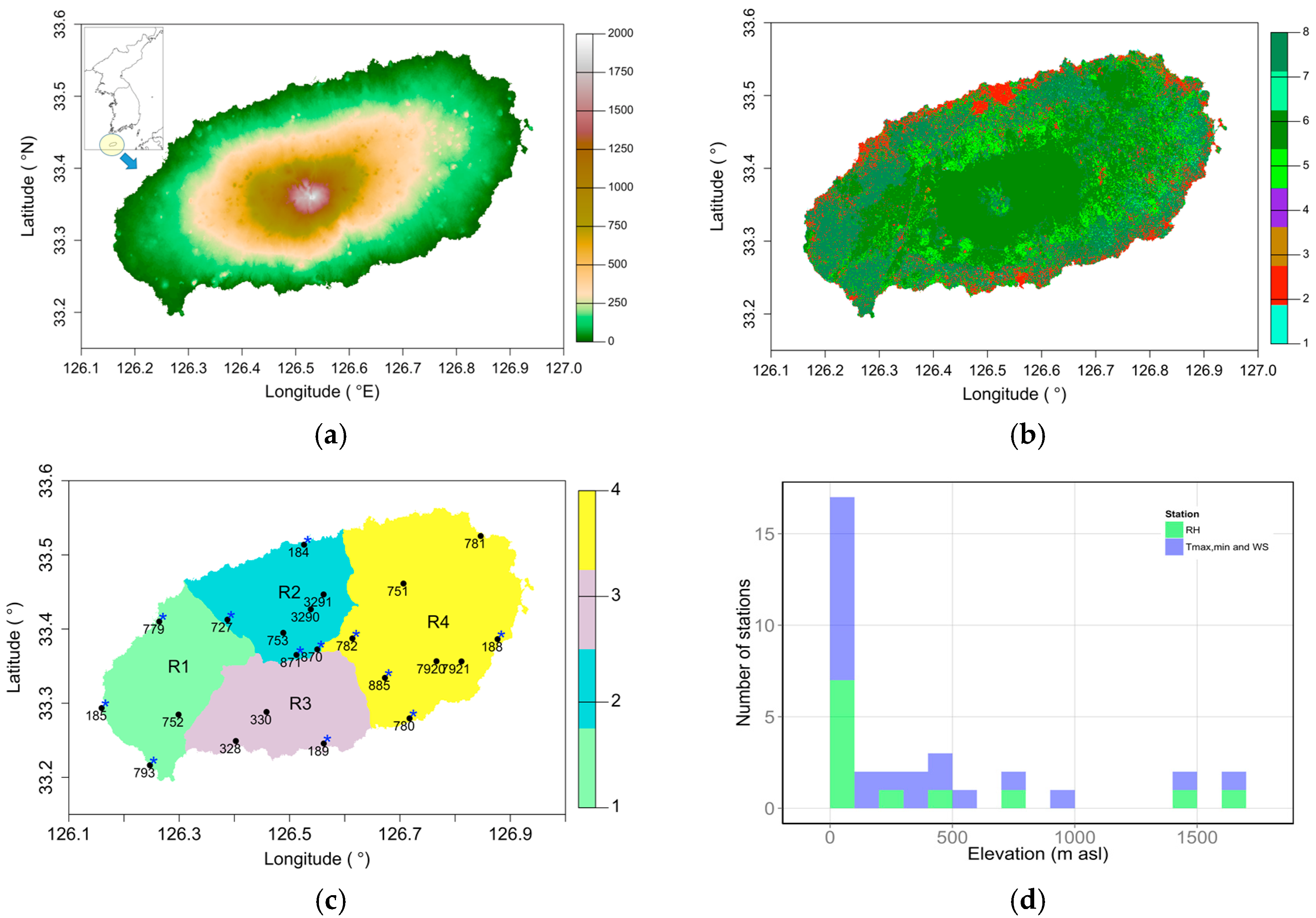
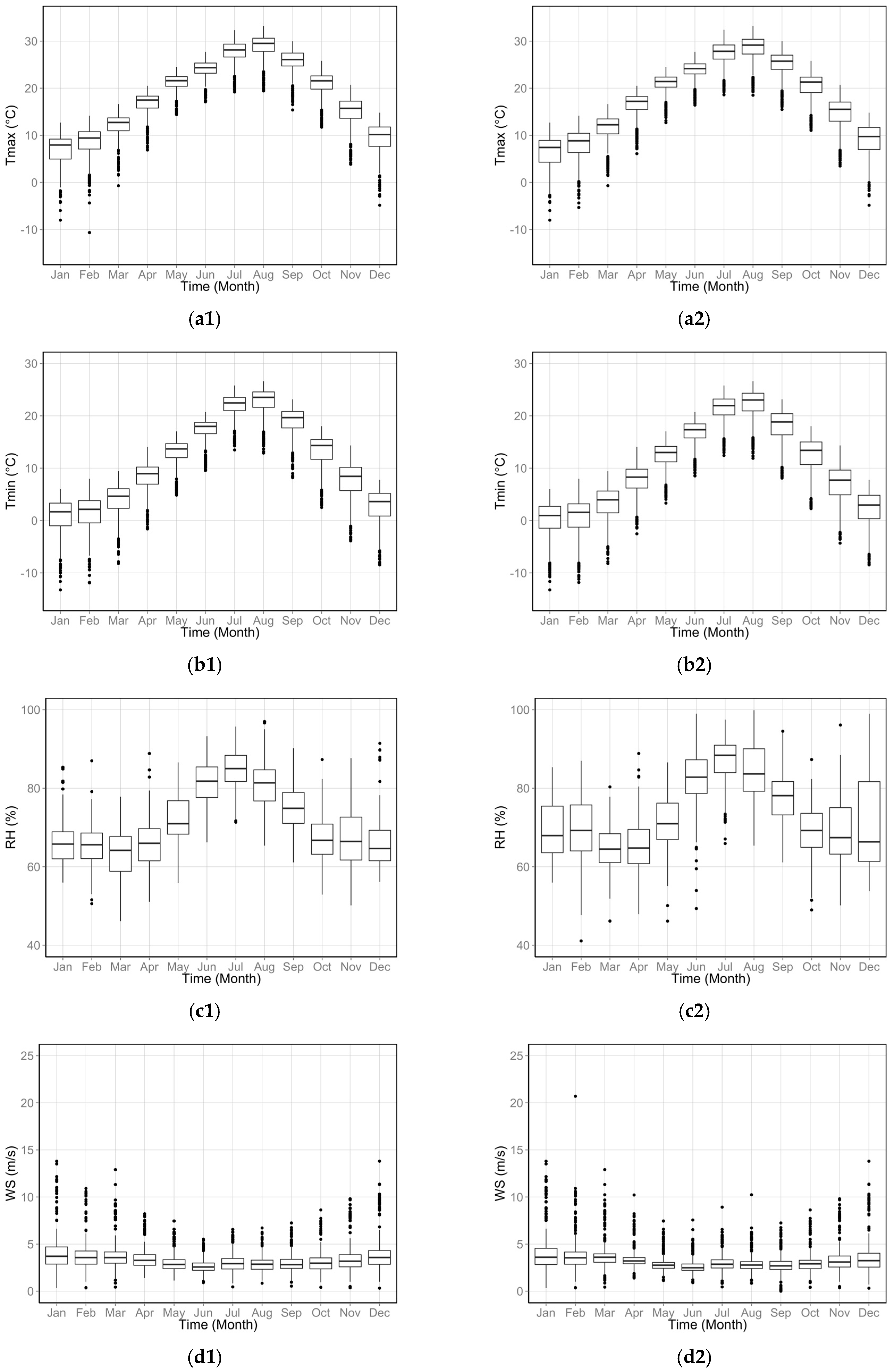
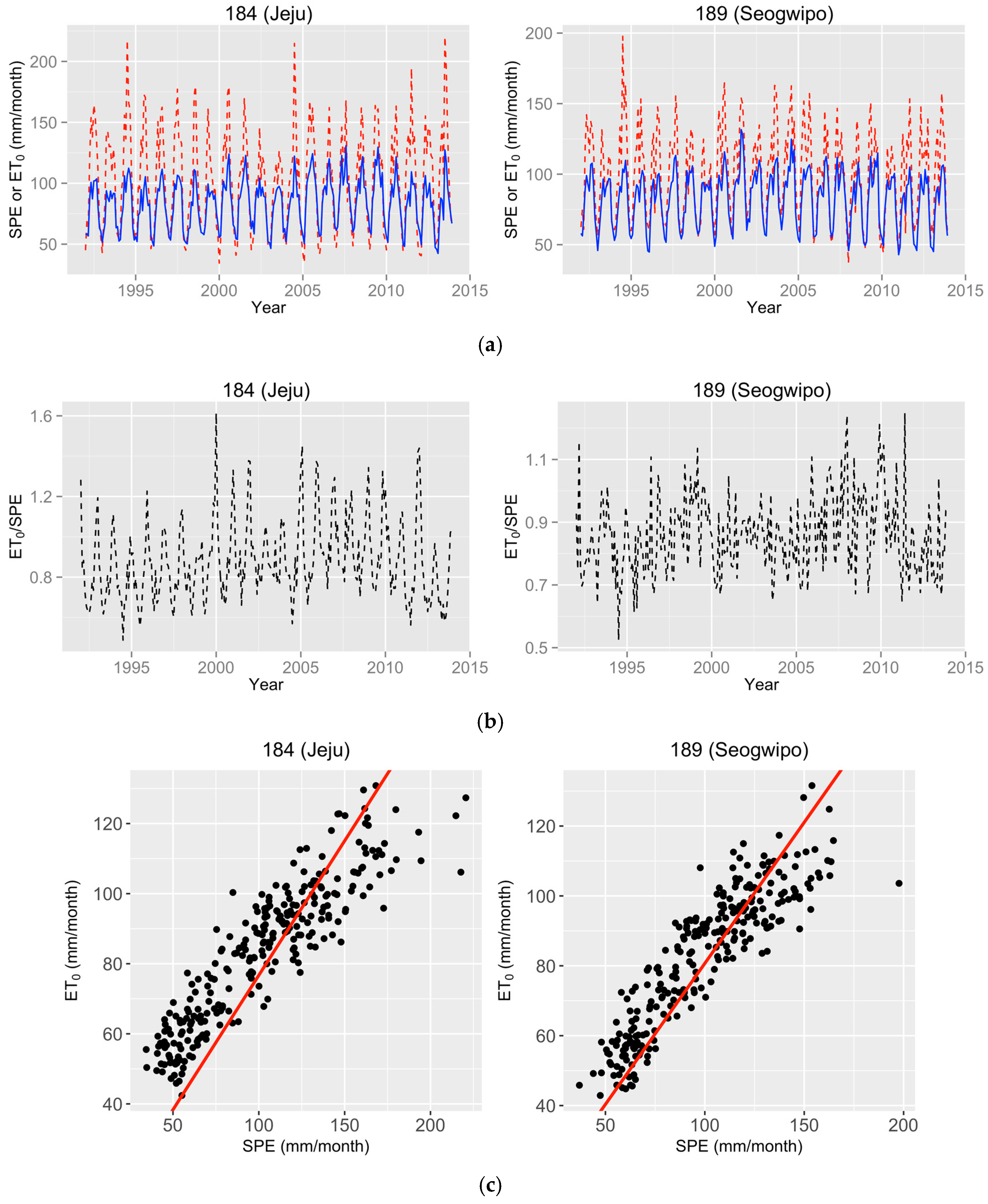
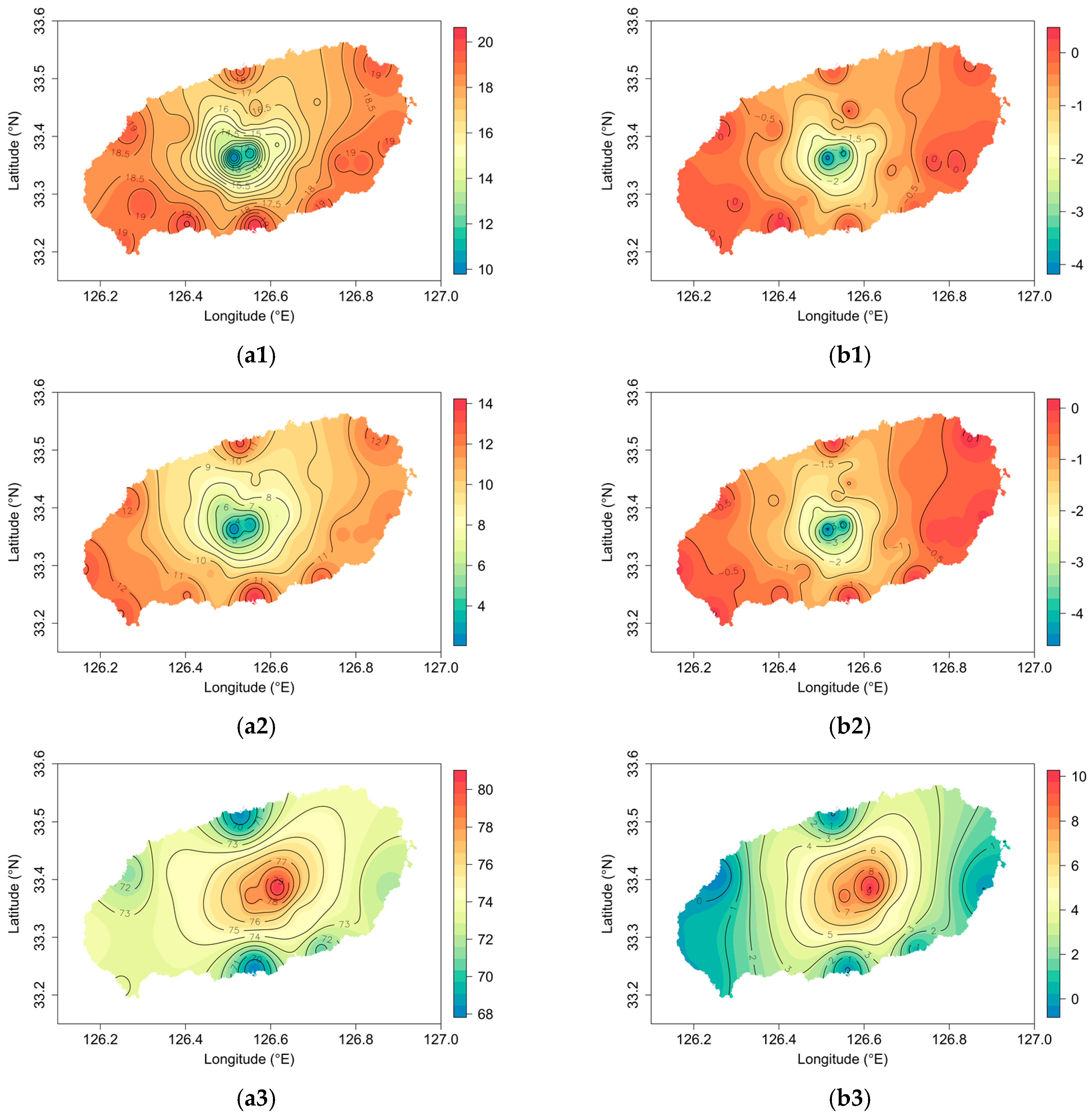
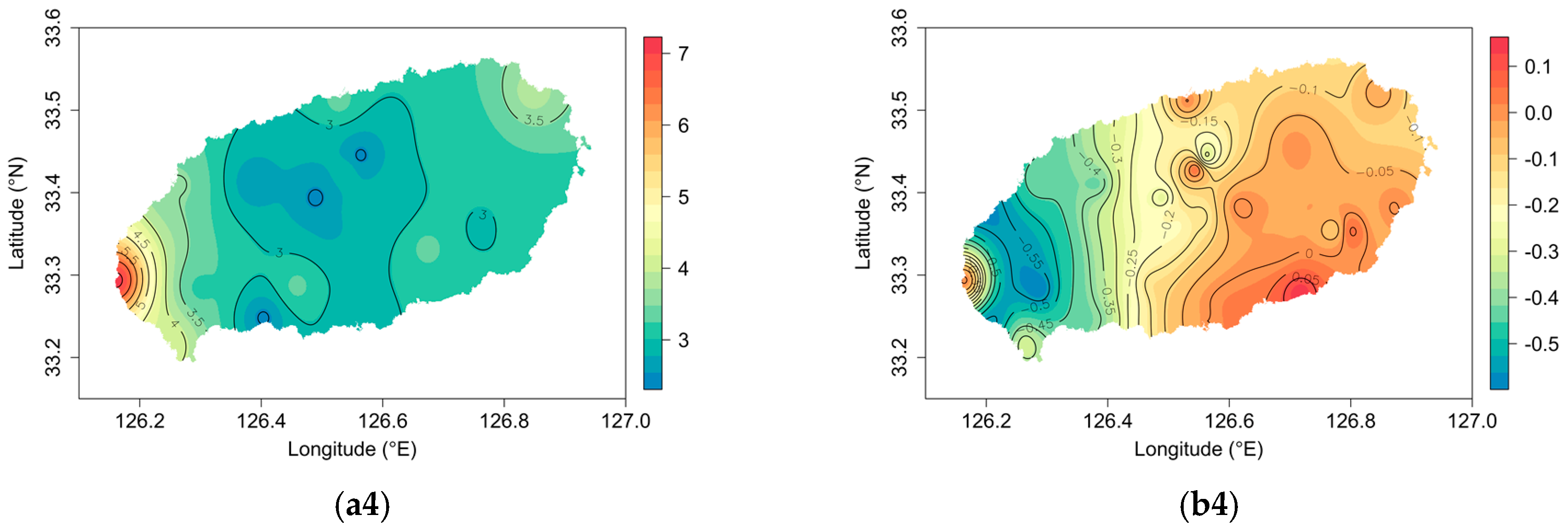
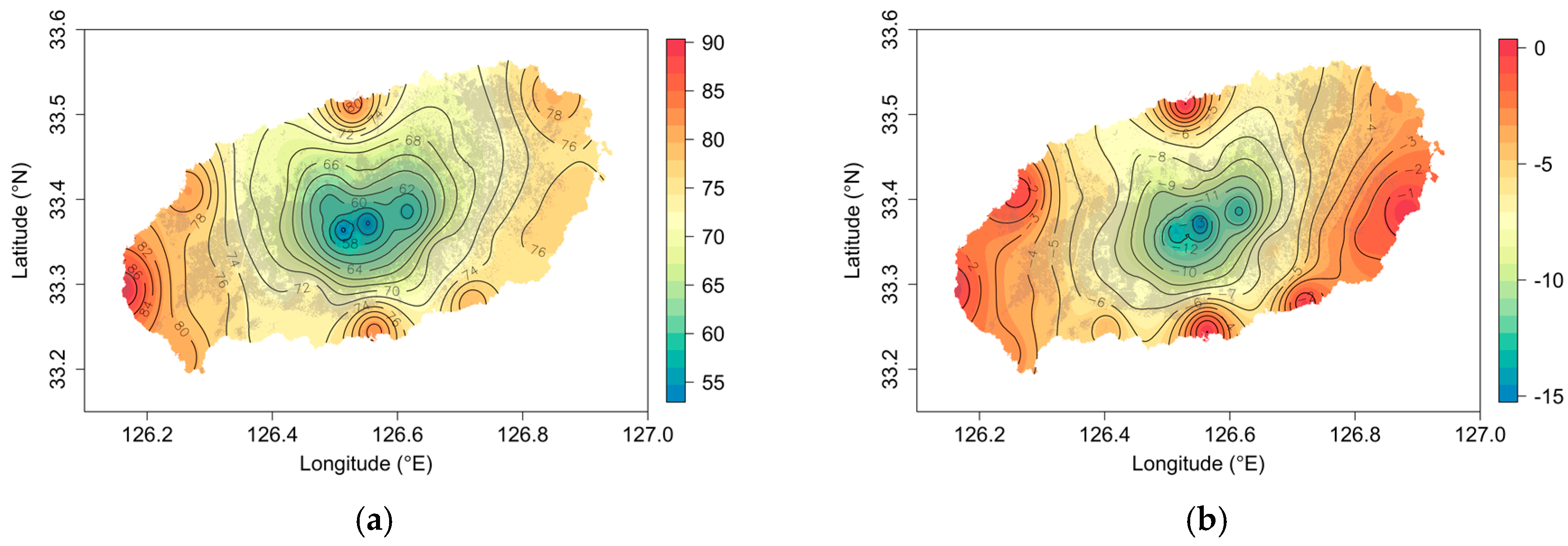
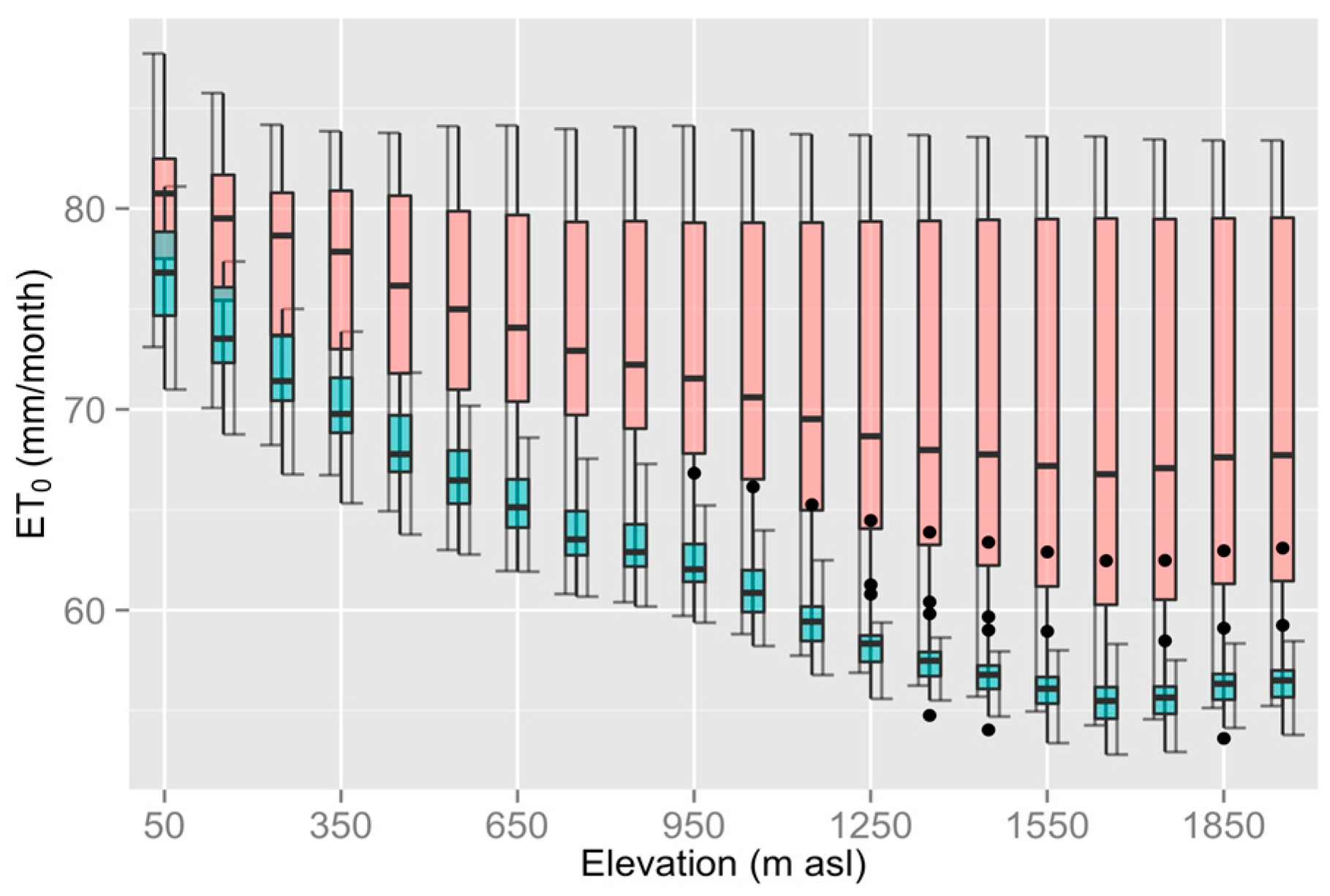
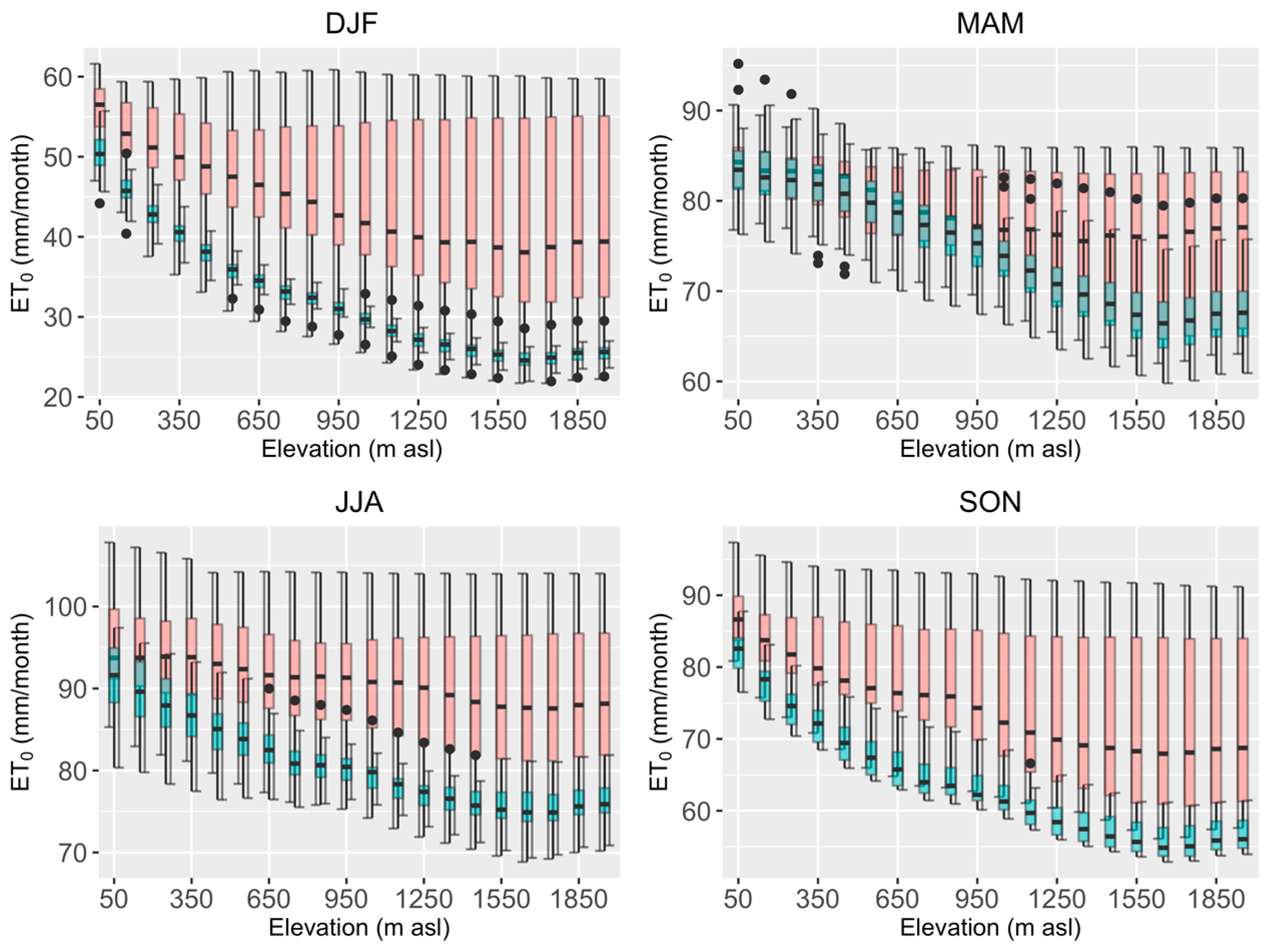
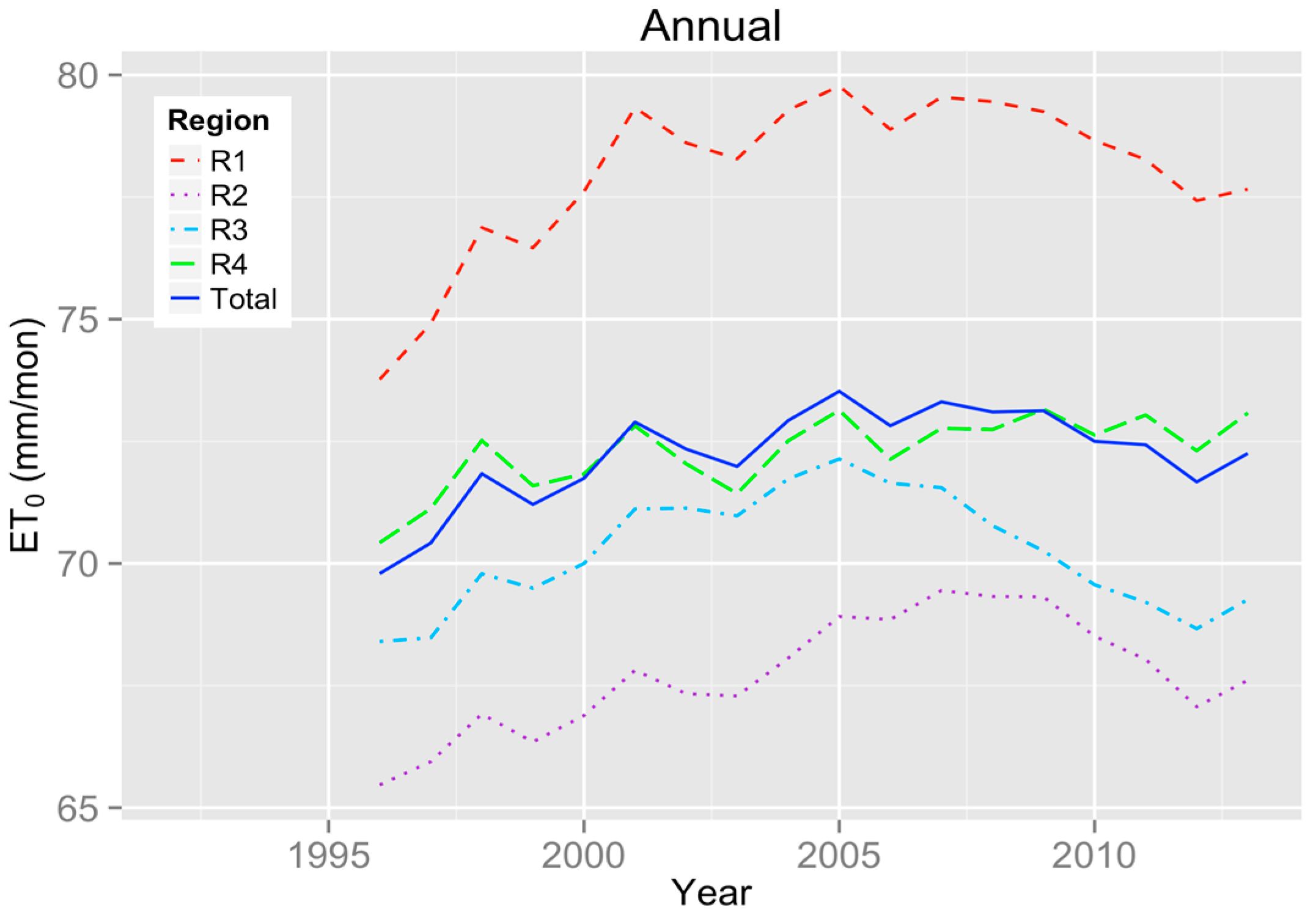
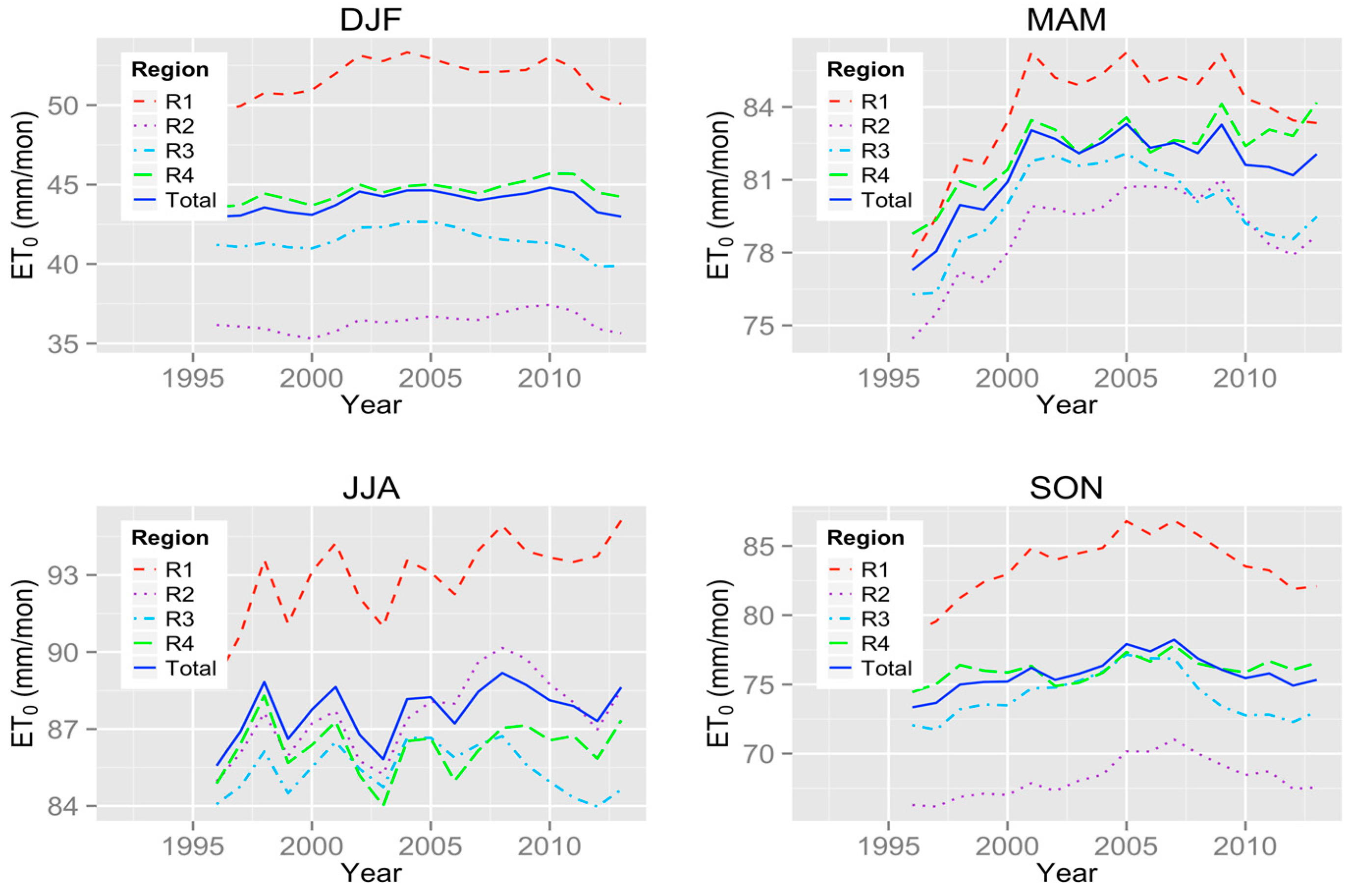
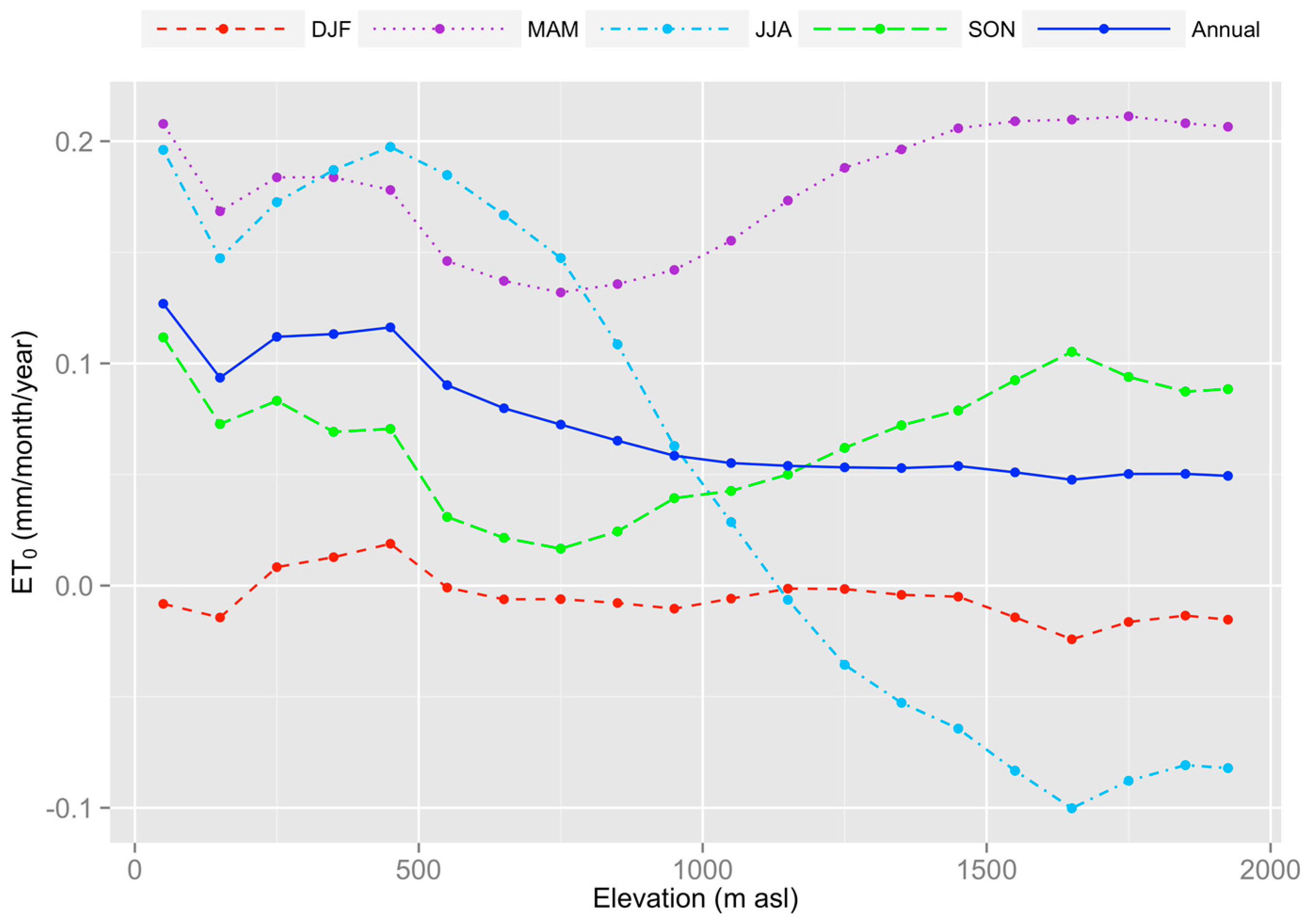
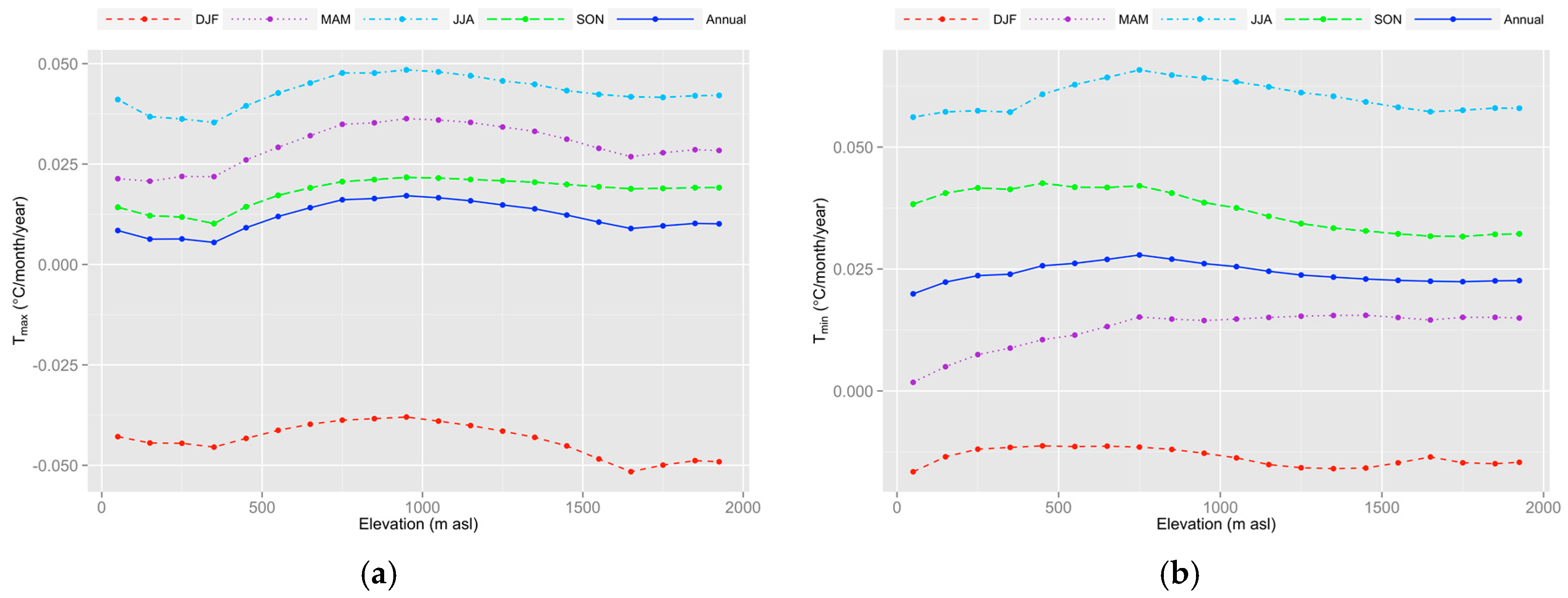
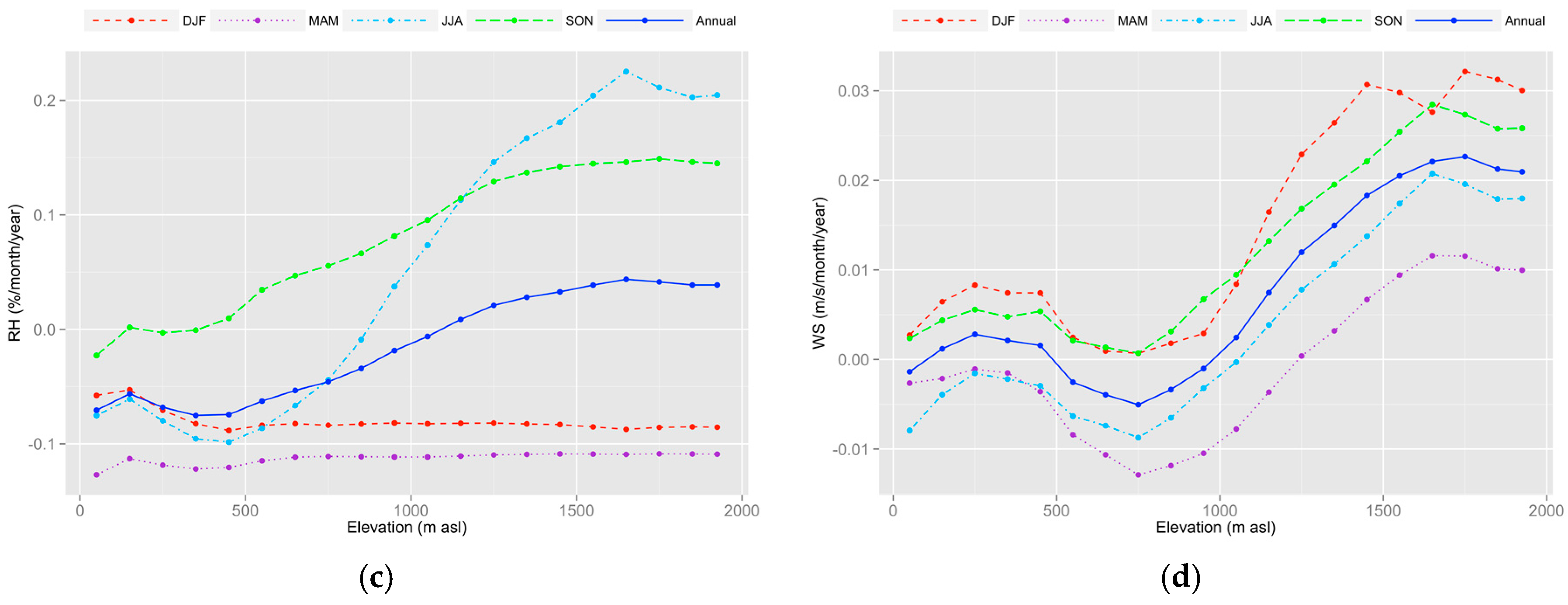
| Variables | Models for Gap Filling | References |
|---|---|---|
| Daily Temperature (max., min.) | Principal component regression: Step (1) Principle component analysis (PCA): Daily temperature at multiple observed sites Step (2) Multiple linear regression : Daily temperature; : Independent variables from PCA; : Coefficients of the regression model. | [16] |
| Monthly Relative Humidity | Multiple linear regression: Monthly relative humidity; Location (in meters) corresponding to longitude in the transverse Mercator projection; Location (in meters) corresponding to latitude in the transverse Mercator projection; : Monthly temperature data; : Coefficients of the regression model. | [17] |
| Monthly Wind | Multiple linear regression: : Monthly wind speed; : Elevation; : Difference between the maximum and minimum temperatures; : Coefficients of the regression model. | [18] |
| Season | Intercept | Slope | Adjusted R2 |
|---|---|---|---|
| DJF | 46.85 | −1.61 × 10−2 | 0.94 |
| MAM | 84.59 | −1.06 × 10−2 | 0.99 |
| JJA | 89.99 | −1.03 × 10−2 | 0.97 |
| SON | 78.78 | −1.63 × 10−2 | 0.94 |
| Annual | 75.05 | −1.33 × 10−2 | 0.97 |
| Season | Elevation (m a.s.l.) | Tmax | Tmin | WS | RH |
|---|---|---|---|---|---|
| DJF | 0–500 | 0.631 | 0.631 | −0.105 | −0.303 |
| 500–1000 | 0.083 | −0.116 | 0.451 | −0.697 | |
| 1000–1500 | −0.090 | −0.351 | 0.492 | −0.851 | |
| 1500–1950 | −0.055 | −0.346 | 0.460 | −0.857 | |
| Total | 0.570 | 0.529 | −0.003 | −0.244 | |
| MAM | 0–500 | 0.951 | 0.916 | −0.706 | 0.281 |
| 500–1000 | 0.960 | 0.940 | −0.558 | 0.050 | |
| 1000–1500 | 0.967 | 0.953 | −0.435 | 0.018 | |
| 1500–1950 | 0.969 | 0.959 | −0.330 | −0.077 | |
| Total | 0.957 | 0.927 | −0.694 | 0.264 | |
| JJA | 0–500 | 0.854 | 0.741 | 0.163 | −0.460 |
| 500–1000 | 0.630 | 0.448 | 0.008 | −0.268 | |
| 1000–1500 | −0.055 | −0.251 | −0.273 | −0.664 | |
| 1500–1950 | −0.389 | −0.557 | −0.377 | −0.869 | |
| Total | 0.834 | 0.710 | 0.130 | −0.354 | |
| SON | 0–500 | 0.905 | 0.882 | −0.479 | 0.381 |
| 500–1000 | 0.898 | 0.867 | −0.363 | 0.022 | |
| 1000–1500 | 0.871 | 0.830 | −0.228 | −0.344 | |
| 1500–1950 | 0.871 | 0.827 | −0.152 | −0.414 | |
| Total | 0.906 | 0.881 | −0.464 | 0.304 |
© 2017 by the authors. Licensee MDPI, Basel, Switzerland. This article is an open access article distributed under the terms and conditions of the Creative Commons Attribution (CC BY) license (http://creativecommons.org/licenses/by/4.0/).
Share and Cite
Um, M.-J.; Kim, Y.; Park, D. Spatial and Temporal Variations in Reference Crop Evapotranspiration in a Mountainous Island, Jeju, in South Korea. Water 2017, 9, 261. https://doi.org/10.3390/w9040261
Um M-J, Kim Y, Park D. Spatial and Temporal Variations in Reference Crop Evapotranspiration in a Mountainous Island, Jeju, in South Korea. Water. 2017; 9(4):261. https://doi.org/10.3390/w9040261
Chicago/Turabian StyleUm, Myoung-Jin, Yeonjoo Kim, and Daeryong Park. 2017. "Spatial and Temporal Variations in Reference Crop Evapotranspiration in a Mountainous Island, Jeju, in South Korea" Water 9, no. 4: 261. https://doi.org/10.3390/w9040261





